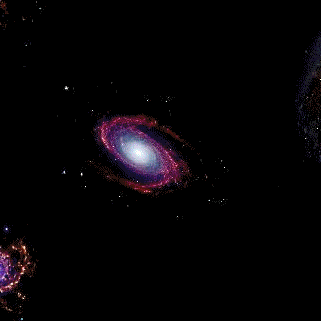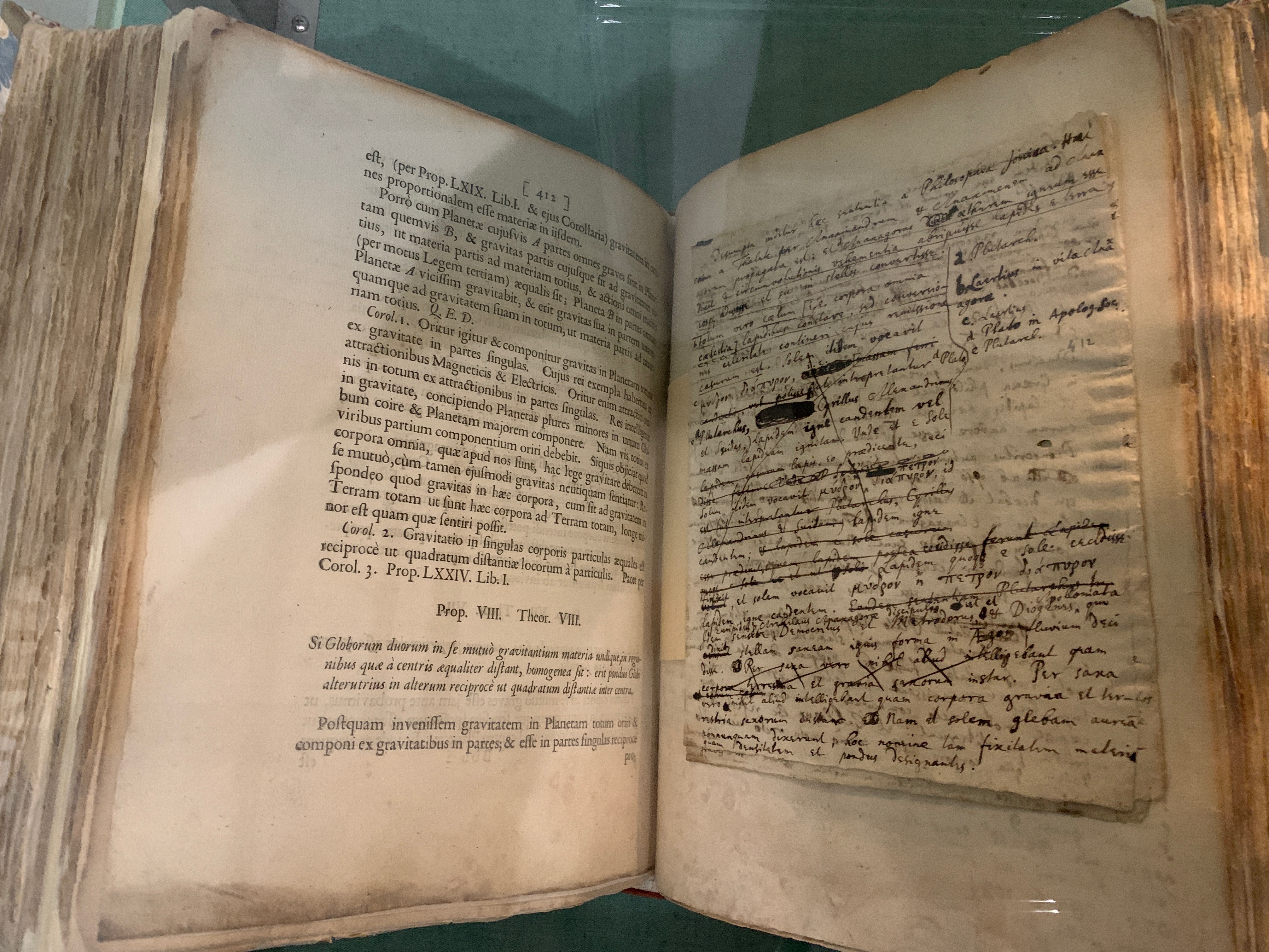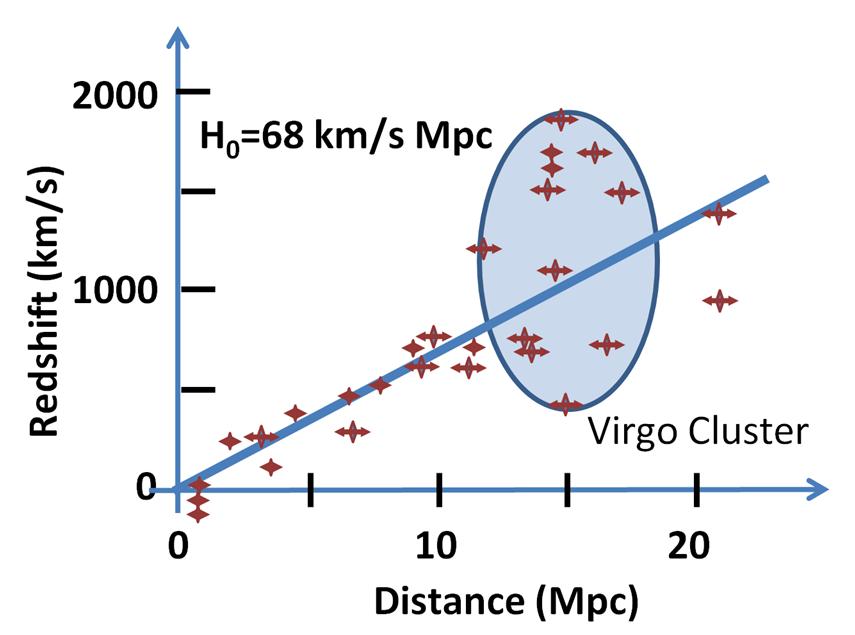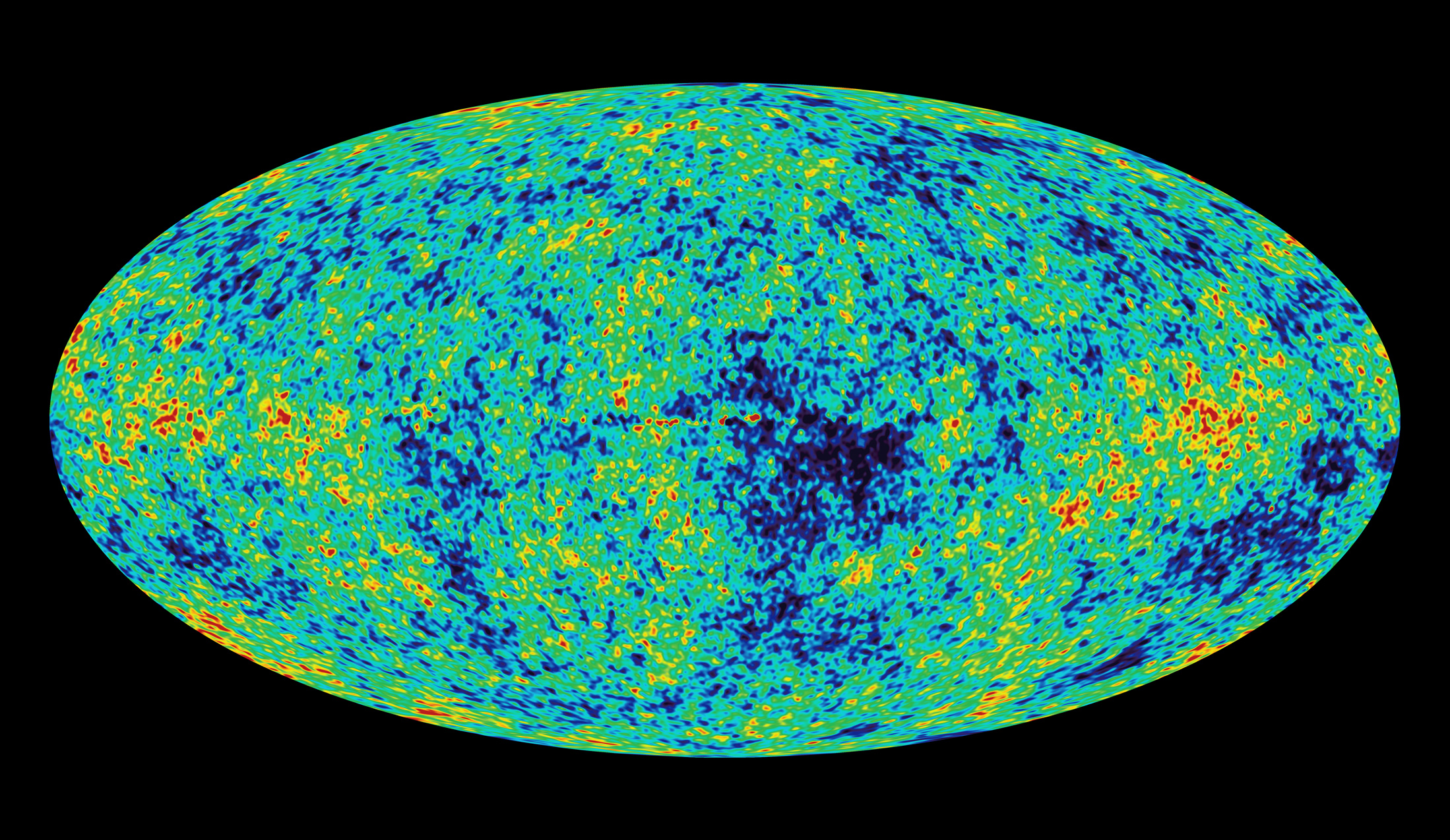Big Crunch on:
[Wikipedia]
[Google]
[Amazon]
 The Big Crunch is a hypothetical scenario for the ultimate fate of the universe, in which the expansion of the universe eventually reverses and the universe recollapses, ultimately causing the cosmic scale factor to reach zero, an event potentially followed by a reformation of the universe starting with another
The Big Crunch is a hypothetical scenario for the ultimate fate of the universe, in which the expansion of the universe eventually reverses and the universe recollapses, ultimately causing the cosmic scale factor to reach zero, an event potentially followed by a reformation of the universe starting with another

 Edwin Hubble working in the Mount Wilson Observatory, he took measurements of the distances of galaxies, and paired them with Vesto Silpher and Milton Humason's measurements of redshifts associated with said galaxies. He discovered a rough proportionality between the redshift of an object and its distance. Though there was quite a bit of scatter, Hubble plotted a trend line from 46 galaxies, studying and obtaining the Hubble Constant, which he deduced to be 500 km/s/Mpc nearly seven times than what it is considered today. Giving the proof that the universe was expanding, and was not a static object.
Edwin Hubble working in the Mount Wilson Observatory, he took measurements of the distances of galaxies, and paired them with Vesto Silpher and Milton Humason's measurements of redshifts associated with said galaxies. He discovered a rough proportionality between the redshift of an object and its distance. Though there was quite a bit of scatter, Hubble plotted a trend line from 46 galaxies, studying and obtaining the Hubble Constant, which he deduced to be 500 km/s/Mpc nearly seven times than what it is considered today. Giving the proof that the universe was expanding, and was not a static object.
 There are more modern theories of Cyclic universes as well. The Ekpyrotic theory, formed by Paul Steinhardt, states that the Big Bang could have been caused by two parallel orbifold planes, referred to as branes colliding in a higher-dimensional space. The four dimension universe lies on one of the branes. The collision corresponds to the Big Crunch, then a Big Bang. The matter and radiation around us today are quantum fluctuations from before the branes. After several billion years the universe has reached its modern state, and it will start contracting in another several billion years. Dark Energy corresponds to the force between both of the branes, allowing for problems, like the flatness and monopole in the previous theories to be fixed. The cycles can also go infinitely into the past and the future, and an
There are more modern theories of Cyclic universes as well. The Ekpyrotic theory, formed by Paul Steinhardt, states that the Big Bang could have been caused by two parallel orbifold planes, referred to as branes colliding in a higher-dimensional space. The four dimension universe lies on one of the branes. The collision corresponds to the Big Crunch, then a Big Bang. The matter and radiation around us today are quantum fluctuations from before the branes. After several billion years the universe has reached its modern state, and it will start contracting in another several billion years. Dark Energy corresponds to the force between both of the branes, allowing for problems, like the flatness and monopole in the previous theories to be fixed. The cycles can also go infinitely into the past and the future, and an
 Physicist Roger Penrose advanced a general relativity-based theory called the conformal cyclic cosmology in which the universe expands until all the matter decays and is turned to light. Since nothing in the universe would have any time or distance scale associated with it, it becomes identical with the Big Bang (resulting in a type of Big Crunch which becomes the next Big Bang, thus starting the next cycle). Penrose and Gurzadyan suggested that signatures of conformal cyclic cosmology could potentially be found in the
Physicist Roger Penrose advanced a general relativity-based theory called the conformal cyclic cosmology in which the universe expands until all the matter decays and is turned to light. Since nothing in the universe would have any time or distance scale associated with it, it becomes identical with the Big Bang (resulting in a type of Big Crunch which becomes the next Big Bang, thus starting the next cycle). Penrose and Gurzadyan suggested that signatures of conformal cyclic cosmology could potentially be found in the
 The Big Crunch is a hypothetical scenario for the ultimate fate of the universe, in which the expansion of the universe eventually reverses and the universe recollapses, ultimately causing the cosmic scale factor to reach zero, an event potentially followed by a reformation of the universe starting with another
The Big Crunch is a hypothetical scenario for the ultimate fate of the universe, in which the expansion of the universe eventually reverses and the universe recollapses, ultimately causing the cosmic scale factor to reach zero, an event potentially followed by a reformation of the universe starting with another Big Bang
The Big Bang event is a physical theory that describes how the universe expanded from an initial state of high density and temperature. Various cosmological models of the Big Bang explain the evolution of the observable universe from t ...
. The vast majority of evidence indicates that this hypothesis is not correct. Instead, astronomical observations show that the expansion of the universe is accelerating, rather than being slowed by gravity
In physics, gravity () is a fundamental interaction which causes mutual attraction between all things with mass or energy. Gravity is, by far, the weakest of the four fundamental interactions, approximately 1038 times weaker than the str ...
, suggesting that the universe is far more likely to end in heat death.
The theory dates back to 1922, with Russian Physicist Alexander Freidmann creating a set of equations showing that the end of the universe depends on its density
Density (volumetric mass density or specific mass) is the substance's mass per unit of volume. The symbol most often used for density is ''ρ'' (the lower case Greek letter rho), although the Latin letter ''D'' can also be used. Mathematicall ...
. It could either expand, or contract rather than stay stable. With enough matter, gravity could stop the universe's expansion, and eventually reversing it. This reversal would result in collapsing the universe on itself, not too dissimilar to a black hole.
The outcome of the universe can be seen by seeing which force will beat out the other, one is the explosive force from the Big Bang, and the other is gravity
In physics, gravity () is a fundamental interaction which causes mutual attraction between all things with mass or energy. Gravity is, by far, the weakest of the four fundamental interactions, approximately 1038 times weaker than the str ...
. If gravity overcomes the explosive force of the Big Bang, then the Big Crunch will start, reversing the Big Bang, however if it fails, heat death is then the most likely scenario. While astronomers know that the universe is expanding, they're not quite sure how large the force of expansion actually is.
The end of the Big Crunch would be filled with radiation
In physics, radiation is the emission or transmission of energy in the form of waves or particles through space or through a material medium. This includes:
* ''electromagnetic radiation'', such as radio waves, microwaves, infrared, vi ...
from stars and high-energy particles, when this is condensed and blueshifted to higher energy, it would be intense enough to ignite the surface of stars before they collide. The Nuclear explosions tearing through any remaining atmosphere
An atmosphere () is a layer of gas or layers of gases that envelop a planet, and is held in place by the gravity of the planetary body. A planet retains an atmosphere when the gravity is great and the temperature of the atmosphere is low. ...
s. It energy would also rip stars apart filling space with plasma. The amount of energy that's condensed could allow for radiation jets up to a thousand light-years long.
Overview
The Big Crunch scenario hypothesized that the density of matter throughout the universe is sufficiently high that gravitational attraction will overcome the expansion which began with the Big Bang. The FLRW cosmology can predict whether the expansion will eventually stop based on the average energy density, Hubble parameter, and cosmological constant. If the metric expansion stopped, then contraction will inevitably follow, accelerating as time passes and finishing the universe in a kind of gravitational collapse, turning the universe into a black hole. Experimental evidence in the late 1990s and early 2000s (namely the observation of distant supernovas as standard candles, and the well-resolved mapping of thecosmic microwave background
In Big Bang cosmology the cosmic microwave background (CMB, CMBR) is electromagnetic radiation that is a remnant from an early stage of the universe, also known as "relic radiation". The CMB is faint cosmic background radiation filling all spac ...
) led to the conclusion that the expansion of the universe is not being slowed by gravity but is instead accelerating. The 2011 Nobel Prize in Physics
)
, image = Nobel Prize.png
, alt = A golden medallion with an embossed image of a bearded man facing left in profile. To the left of the man is the text "ALFR•" then "NOBEL", and on the right, the text (smaller) "NAT•" then " ...
was awarded to researchers who contributed to making this discovery.
The Big Crunch theory also leads into another theory known as the Big Bounce, a theory in which after the big crunch destroys the universe, it does a sort of bounce, causing another big bang. This could potentially repeat forever in a phenomena known as a Cyclic universe.
History
Richard Bentley, a churchman and a scholar, in preparation of a lecture of Newton's theories and the rejection ofatheism
Atheism, in the broadest sense, is an absence of belief in the existence of deities. Less broadly, atheism is a rejection of the belief that any deities exist. In an even narrower sense, atheism is specifically the position that there no ...
, sent a letter out to Sir Issac Newton: If we're in a finite universe and all stars attract each other together, would they not all collapse to a singular point, and if we're in an infinite universe with infinite stars, would infinite forces in every direction not affect all of those stars? This question is known as Bentley's paradox
Bentley's paradox (named after Richard Bentley) is a cosmological paradox pointing to a problem occurring when Newton's theory of gravitation is applied to cosmology. Namely, if all the stars are drawn to each other by gravitation, they should col ...
, a kind of proto-theory of the Big Crunch. Although, it is now known that stars move around and aren't static.

Einstein's cosmological constant
Albert Einstein
Albert Einstein ( ; ; 14 March 1879 – 18 April 1955) was a German-born theoretical physicist, widely acknowledged to be one of the greatest and most influential physicists of all time. Einstein is best known for developing the theor ...
favored a completely unchanging model of the universe, he collaborated in 1917 with Dutch astronomer Willem de Sittergeneral relativity
General relativity, also known as the general theory of relativity and Einstein's theory of gravity, is the geometric theory of gravitation published by Albert Einstein in 1915 and is the current description of gravitation in modern physics. ...
would work with a static model, Willem demonstrated that his equations could describe a very simple universe. Finding no problems initially, scientists adapted the model to describe the universe, however they ran into a different form of Bentley's paradox.
However, the theory of general relativity itself also described the universe as restless, contradicting the information he found, Einstein realizing that in order for a static universe to exist,—something that was currently being observed—an anti-gravity would be needed to counter the gravity contracting the universe together. An extra force would mess up his theory of relativity, an idea that he hated. In the end, the cosmological constant, the name for this anti-gravity force, was added to the theory of relativity.
Discovery of Hubble's law
Abandonment of the cosmological constant
After the publishing Hubble's discovery, Einstein completely abandoned the cosmological constant. The equations at their simplest form generated a model of the universe that expanded or contracted, hence the creation of the cosmological constant. After the confirmation that the universe was expanding. Einstein called his assumption that the universe was completely static his, "biggest mistake." In 1931, Einstein visited Hubble to thank him for providing the basis of modern cosmology. After this discovery, Einstein and Newtons models of a contracting, yet static universe, was dropped in favor for the model of the expanding universe.Cyclic universes
A theory called " Big Bounce" proposes that the universe could collapse to the state where it began and then initiate another Big Bang, so in this way the universe would last forever, but would pass through phases of expansion (Big Bang) and contraction (Big Crunch). This means that there may be a universe in a state of constant Big Bangs and Big Crunches. Cyclic universes were briefly considered byAlbert Einstein
Albert Einstein ( ; ; 14 March 1879 – 18 April 1955) was a German-born theoretical physicist, widely acknowledged to be one of the greatest and most influential physicists of all time. Einstein is best known for developing the theor ...
in 1931. He theorized that there was a universe before the Big Bang which ended in a Big Crunch, which could create a Big Bang as a reaction. Our universe could potentially be in a cycle of expansion and contraction, in a reaction that could go on potentially infinitely.
Ekpyrotic model
attractor
In the mathematical field of dynamical systems, an attractor is a set of states toward which a system tends to evolve, for a wide variety of starting conditions of the system. System values that get close enough to the attractor values remain ...
allows for a complete history of the universe.
This fixes the problem of the earlier model of the universe going into heat death from entropy
Entropy is a scientific concept, as well as a measurable physical property, that is most commonly associated with a state of disorder, randomness, or uncertainty. The term and the concept are used in diverse fields, from classical thermodyna ...
buildup. The new model avoids this with a net expansion after every cycle, stopping entropy buildup. However, there are still some flaws in this model. The basis of the theory, branes, are still not understood completely by string theorist, and the possibility that the scale invariant spectrum could be destroyed from the big crunch. While cosmic inflation and the general character of the forces—or the collision of the branes in the Ekpyrotic model—required to make vacuum fluctuations is known. A candidate from particle physics
Particle physics or high energy physics is the study of fundamental particles and forces that constitute matter and radiation. The fundamental particles in the universe are classified in the Standard Model as fermions (matter particles) and ...
is missing.
Conformal Cyclic Cosmology (CCC) model
 Physicist Roger Penrose advanced a general relativity-based theory called the conformal cyclic cosmology in which the universe expands until all the matter decays and is turned to light. Since nothing in the universe would have any time or distance scale associated with it, it becomes identical with the Big Bang (resulting in a type of Big Crunch which becomes the next Big Bang, thus starting the next cycle). Penrose and Gurzadyan suggested that signatures of conformal cyclic cosmology could potentially be found in the
Physicist Roger Penrose advanced a general relativity-based theory called the conformal cyclic cosmology in which the universe expands until all the matter decays and is turned to light. Since nothing in the universe would have any time or distance scale associated with it, it becomes identical with the Big Bang (resulting in a type of Big Crunch which becomes the next Big Bang, thus starting the next cycle). Penrose and Gurzadyan suggested that signatures of conformal cyclic cosmology could potentially be found in the cosmic microwave background
In Big Bang cosmology the cosmic microwave background (CMB, CMBR) is electromagnetic radiation that is a remnant from an early stage of the universe, also known as "relic radiation". The CMB is faint cosmic background radiation filling all spac ...
; as of 2020, these have not been detected.
There are also some flaws with this theory as well, skeptics pointed out that in order to match up an infinitely large universe to an infinitely small universe, that all particles must lose their mass when the universe gets old. However, Penrose presented evidence of CCC in the form of rings that had uniform temperature in the CMB, the idea being that these rings would be the signature in our aeon—An aeon being the current cycle of the universe that we're in—was caused by spherical gravitational waves caused by colliding black holes from our previous aeon.
Loop quantum cosmology (LQC)
Loop quantum cosmology is a model of the universe that proposes a "quantum-bridge" between expanding and contracting universes. In this model quantum geometry creates a brand new force negligible at low space-time curvature. However, rising very rapidly in the Planck regime, overwhelming classical gravity which resolves singularities ofgeneral relativity
General relativity, also known as the general theory of relativity and Einstein's theory of gravity, is the geometric theory of gravitation published by Albert Einstein in 1915 and is the current description of gravitation in modern physics. ...
. Once the singularities are resolved the conceptual paradigm of cosmology changes, forcing one to revisit the standard issues—such as the horizon problem—from a new perspective.
Due to quantum geometry, the Big Bang is replaced by the Big Bounce with no assumptions or any fine tuning. An important feature of the theory being the space-time description of the underlying quantum evolution. The approach of effective dynamics have been used extensively in loop quantum cosmology to describe physics at the Planck-scale and also the beginning of the universe. Numerical simulations have confirmed the validity of effective dynamics, which provides a good approximation of the full loop quantum dynamics. It has been shown when states have very large quantum fluctuations at late times, meaning they do not lead to macroscopic universes as described by general relativity, but the effective dynamics departs from quantum dynamics near bounce and the later universe. In this case, the effective dynamics will overestimate the density at bounce, but it will still capture qualitative aspects extremely well.
Empirical scenarios from physical theories
If a form of quintessence driven by a scalar field evolving down a monotonically decreasing potential that passes sufficiently below zero is the (main) explanation of dark energy and current data (in particular observational constraints on dark energy) is true as well, the accelerating expansion of the Universe would inverse to contraction within the cosmic near-future of the next 100 million years. According to an Andrei-Ijjas-Steinhardt study, the scenario fits "naturally with cyclic cosmologies and recent conjectures about quantum gravity". The study suggests that the slow contraction phase would "endure for a period of order 1 billion y before the universe transitions to a new phase of expansion".Effects
Paul Davies considered a scenario in which the Big Crunch happens about 100 billion years from the present. In his model, the contracting universe would evolve roughly like the expanding phase in reverse. First, galaxy clusters, and then galaxies, would merge, and the temperature of thecosmic microwave background
In Big Bang cosmology the cosmic microwave background (CMB, CMBR) is electromagnetic radiation that is a remnant from an early stage of the universe, also known as "relic radiation". The CMB is faint cosmic background radiation filling all spac ...
(CMB) would begin to rise as CMB photons get blueshifted. Stars would eventually become so close together that they begin to collide with each other. Once the CMB becomes hotter than M-type stars (about 500,000 years before the Big Crunch in Davies' model), they would no longer be able to radiate away their heat and would cook themselves until they evaporate; this continues for successively hotter stars until O-type stars boil away about 100,000 years before the Big Crunch. In the last minutes, the temperature of the universe would be so great that atom
Every atom is composed of a nucleus and one or more electrons bound to the nucleus. The nucleus is made of one or more protons and a number of neutrons. Only the most common variety of hydrogen has no neutrons.
Every solid, liquid, gas ...
s and atomic nuclei
The atomic nucleus is the small, dense region consisting of protons and neutrons at the center of an atom, discovered in 1911 by Ernest Rutherford based on the 1909 Geiger–Marsden gold foil experiment. After the discovery of the neutron in ...
would break up and get sucked up into already coalescing black holes. At the time of the Big Crunch, all the matter in the universe would be crushed into an infinitely hot, infinitely dense singularity similar to the Big Bang
The Big Bang event is a physical theory that describes how the universe expanded from an initial state of high density and temperature. Various cosmological models of the Big Bang explain the evolution of the observable universe from t ...
. The Big Crunch may be followed by another Big Bang, creating a new universe.
See also
* * * * * * * *References
{{Authority control Physical cosmology Ultimate fate of the universe